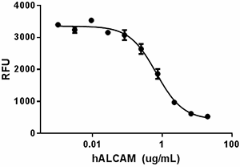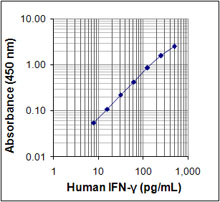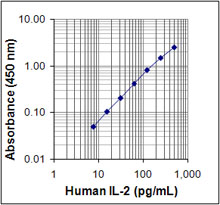- Regulatory Status
- RUO
- Other Names
- Activated leukocyte cell adhesion molecule, CD166, MEMD
- Ave. Rating
- Submit a Review
- Product Citations
- publications

-

Recombinant human ALCAM blocks adhesion of Jurkat cells to immobilized human CD6. ED50 for this effect is 0.4 - 1.6 µg/mL. The Deep Blue Cell Viability™ Kit was used measure the number of adherent cells. -

Human ALCAM was aliquoted in 20mM Tris, 150mM NaCl, pH 7.2 at 0.2 mg/ml. One aliquot was freeze and thawed four times (squares), and compared to a control kept at 4°C (circles). The samples were tested for their ability to block adhesion of Jurkat cells to immobilized human CD6.
| Cat # | Size | Price | Save |
|---|---|---|---|
| 768804 | 25 µg | ¥66,670 | |
| 768806 | 100 µg | ¥180,900 |
Activated leukocyte cell adhesion molecule (ALCAM), designated as CD166, is a highly conserved 110 kDa transmembrane type-I glycoprotein that was first described as a CD6 ligand on leukocytes. 583 amino acids ALCAM consists of a 27 amino acids signal peptide followed by a 500 amino acids extracellular domain, a 22 amino acids transmembrane domain, and a 34 amino acids cytoplasmic domain. The amino acid sequence has shown to be homologous to neurolin, RAGE, and MUC18. ALCAM is expressed in a wide range of cells including neuronal, immune, epithelial, and stem cells of hematopoietic and mesenchymal origin. ALCAM mediates homotypic interactions as well as heterotypic interactions. ALCAM’s heterotypic interaction helps to mediate adhesion, migration, and tube formation in lymphatic endothelial cells. It also supports dendritic cell adhesion to lymphatic endothelium, and plays important role in hematopoiesis and axon fasciculation. ALCAM is the only known ligand for CD6 and their interaction contributes to immunological synapse, T cell activation and proliferation. ALCAM also promotes neurite extension, axon growth and axon guidance. It mediates outgrowth and pathfinding for retinal ganglion cell axons. ALCAM expression has been shown to correlate with enhanced melanoma invasion and metastasis, however anti-metastatic activity has also been reported in breast cancer.
Product DetailsProduct Details
- Source
- Human ALCAM, amino acids Trp28-Ala526 (Accession # BC137096) with a C-terminal human IgG1 Fc was expressed in 293E cells.
- Molecular Mass
- The 738 amino acid recombinant protein has a predicted molecular mass of approximately 82.8 kDa. The DTT-reduced protein migrates at approximately 90 kDa and and non-reduced protein migrates at approximately 180 kDa by SDS-PAGE. The predicted N-terminal amino acid is Trp.
- Purity
- >95%, as determined by Coomassie stained SDS-PAGE.
- Formulation
- 0.22 µm filtered protein solution is in 20mM Tris, 150mM NaCl, pH 7.5
- Endotoxin Level
- Less than 1.0 EU per µg protein as determined by the LAL method.
- Concentration
- 10 and 25 µg sizes are bottled at 200 µg/mL. 100 µg size and larger sizes are lot-specific and bottled at the concentration indicated on the vial. To obtain lot-specific concentration and expiration, please enter the lot number in our Certificate of Analysis online tool.
- Storage & Handling
- Unopened vial can be stored between 2°C and 8°C for up to 2 weeks, at -20°C for up to six months, or at -70°C or colder until the expiration date. For maximum results, quick spin vial prior to opening. The protein can be aliquoted and stored at -20°C or colder. Stock solutions can also be prepared at 50 - 100 µg/mL in appropriate sterile buffer, carrier protein such as 0.2 - 1% BSA or HSA can be added when preparing the stock solution. Aliquots can be stored between 2°C and 8°C for up to one week and stored at -20°C or colder for up to 3 months. Avoid repeated freeze/thaw cycles.
- Activity
- ED50= 0.4 - 1.6 µg/mL as measured by its ability to block the adhesion of Jurkat cells to immobilized human CD6. The Deep Blue Cell Viability™ Kit was used measure the number of adherent cells.
- Application
-
Bioassay
- Application Notes
-
BioLegend carrier-free recombinant proteins provided in liquid format are shipped on blue-ice. Our comparison testing data indicates that when handled and stored as recommended, the liquid format has equal or better stability and shelf-life compared to commercially available lyophilized proteins after reconstitution. Our liquid proteins are verified in-house to maintain activity after shipping on blue ice and are backed by our 100% satisfaction guarantee. If you have any concerns, contact us at tech@biolegend.com.
Antigen Details
- Structure
- Homodimer
- Distribution
-
Neurons, immune cells, epithelial cells, and stem cells of hematopoietic and mesenchymal origin.
- Function
- Cell adhesion molecule that mediates both heterotypic cell-cell contacts via its interaction with CD6, as well as homotypic cell-cell contacts.
- Interaction
- Endothelial cells, immune cells, epithelial cells, and neurons.
- Ligand/Receptor
- CD6
- Bioactivity
- Measured by its ability to block the adhesion of Jurkat cells to immobilized human CD6.
- Biology Area
- Immunology, Stem Cells
- Molecular Family
- Adhesion Molecules, CD Molecules, Soluble Receptors
- Antigen References
-
1. Skonier JE, et al. 1996. Biochemistry 35:12287.
2. Bowen MA, et al. 1995. J Exp Med. 181:2213.
3. Saifullah MK, et al. 2004. J. Immun. 173:6125.
4. Ikeda K, Quertermous T. 2004. J Biol Chem. 279:55315.
5. Zimmerman AW, et al. 2006. Blood. 107:3212-20.
6. Iolyeva M, et al. 2013. FASEB J. 27:978.
7. Chitteti BR, et al. 2014. Blood. 124: 519. - Gene ID
- 214 View all products for this Gene ID
- UniProt
- View information about ALCAM/CD166 on UniProt.org
Related Pages & Pathways
Pages
Related FAQs
- Why choose BioLegend recombinant proteins?
-
• Each lot of product is quality-tested for bioactivity as indicated on the data sheet.
• Greater than 95% Purity or higher, tested on every lot of product.
• 100% Satisfaction Guarantee for quality performance, stability, and consistency.
• Ready-to-use liquid format saves time and reduces challenges associated with reconstitution.
• Bulk and customization available. Contact us.
• Learn more about our Recombinant Proteins. - How does the activity of your recombinant proteins compare to competitors?
-
We quality control each and every lot of recombinant protein. Not only do we check its bioactivity, but we also compare it against other commercially available recombinant proteins. We make sure each recombinant protein’s activity is at least as good as or better than the competition’s. In order to provide you with the best possible product, we ensure that our testing process is rigorous and thorough. If you’re curious and eager to make the switch to BioLegend recombinants, contact your sales representative today!
- What is the specific activity or ED50 of my recombinant protein?
-
The specific activity range of the protein is indicated on the product datasheets. Because the exact activity values on a per unit basis can largely fluctuate depending on a number of factors, including the nature of the assay, cell density, age of cells/passage number, culture media used, and end user technique, the specific activity is best defined as a range and we guarantee the specific activity of all our lots will be within the range indicated on the datasheet. Please note this only applies to recombinants labeled for use in bioassays. ELISA standard recombinant proteins are not recommended for bioassay usage as they are not tested for these applications.
- Have your recombinants been tested for stability?
-
Our testing shows that the recombinant proteins are able to withstand room temperature for a week without losing activity. In addition the recombinant proteins were also found to withstand four cycles of freeze and thaw without losing activity.
- Does specific activity of a recombinant protein vary between lots?
-
Specific activity will vary for each lot and for the type of experiment that is done to validate it, but all passed lots will have activity within the established ED50 range for the product and we guarantee that our products will have lot-to-lot consistency. Please conduct an experiment-specific validation to find the optimal ED50 for your system.
- How do you convert activity as an ED50 in ng/ml to a specific activity in Units/mg?
-
Use formula Specific activity (Units/mg) = 10^6/ ED50 (ng/mL)













Follow Us